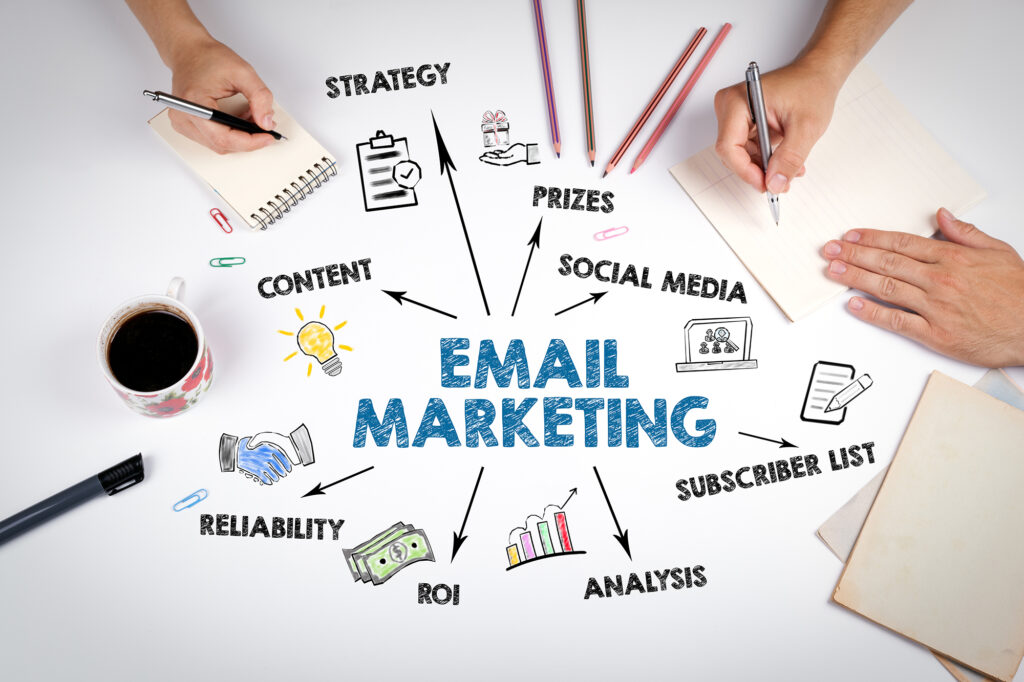A Beginner’s Guide to Email Newsletters: Building Connections, Sharing Stories, and Engaging Audiences

In a world inundated with tweets, posts, snaps, and stories, there’s something refreshingly personal about an email newsletter. It’s like receiving a letter from a friend in your inbox, filled with curated content, insights, and updates. As both a communication tool and a marketing strategy, email newsletters have proven to be incredibly effective in building connections, sharing stories, and engaging audiences. In this beginner’s guide, we’ll explore email newsletters’ what, why, and how and how they can benefit individuals and businesses. What is an Email Newsletter? Simply put, an email newsletter is a regular email sent to subscribers who have opted in to receive updates from you or your organization. It typically contains news, articles, promotions, announcements, and personal messages. Newsletters can vary in frequency, from daily digests to weekly roundups or monthly updates, depending on the goals and resources of the sender. Why Start an Email Newsletter? How to Start an Email Newsletter Conclusion Email newsletters are a powerful tool for connecting with your audience, sharing your story, and achieving your personal or professional goals. By delivering valuable content directly to subscribers’ inboxes, you can build relationships, drive engagement, and, ultimately, make an impact. So why wait? Start crafting your newsletter today and watch your audience grow and thrive.
Unlocking Success: Tips and Tricks for Building a Powerful Email Marketing List

Introduction: In the ever-evolving digital marketing landscape, email remains a potent tool for businesses to connect with their audience. Building a successful email marketing list is a crucial step in leveraging the power of this channel. In this blog post, we’ll explore key tips and tricks to help you build a robust and engaged email marketing list. Conclusion: Building a successful email marketing list requires a thoughtful and strategic approach. By creating valuable content, optimizing sign-up processes, and leveraging various channels, you can cultivate an engaged and loyal subscriber base. Implement these tips and tricks to unlock the full potential of your email marketing efforts.
Mastering Facebook Ad Optimization: Unleashing the Power of Website Analytics for Success

Analyzing website analytics to optimize Facebook ads is a crucial step in maximizing the effectiveness of your digital marketing efforts. By leveraging the data provided by website analytics tools, you can gain valuable insights into user behavior, preferences, and conversion patterns. Here’s a comprehensive guide on how to use your website analytics to optimize your Facebook ads: 1. Integrate Facebook Pixel: 2. Define Key Metrics: 3. Analyze Audience Demographics: 4. Track Conversion Paths: 5. Segment Your Audience: 6. Optimize Ad Creative: 7. Leverage Retargeting: 8. Monitor Ad Placement Performance: 9. A/B Testing: 10. Adjust Ad Scheduling: 11. Monitor Mobile Performance: 12. Evaluate Ad ROI: Conclusion: Effectively utilizing website analytics to optimize Facebook ads is an ongoing process. Regularly analyze data, make informed adjustments, and stay updated on industry trends to ensure your digital marketing strategy remains effective and aligned with your business objectives.
Boosting Engagement and Efficiency: The Compelling Reasons to Use a Chatbot on Your Website

Introduction: In today’s fast-paced digital era, businesses constantly seek innovative ways to enhance user experience and streamline communication. One tool that has gained significant popularity in recent years is the chatbot. These artificial intelligence-driven conversational agents have proven invaluable assets for websites across various industries. In this blog post, we’ll explore why incorporating a chatbot on your website can be a game-changer. One of the primary advantages of using a chatbot is its ability to provide round-the-clock assistance. Unlike human agents, chatbots don’t require breaks or sleep, ensuring your website is always ready to engage with users. This 24/7 availability is especially crucial for global businesses catering to audiences in different time zones. Chatbots excel at delivering instantaneous responses to user queries. This speed not only enhances user satisfaction but also contributes to the overall efficiency of your website. Users appreciate quick and accurate information, and a well-programmed chatbot can provide just that, making the interaction seamless and user-friendly. Implementing a chatbot for basic customer support tasks can significantly reduce operational costs. Routine queries, frequently asked questions, and simple problem-solving can be handled efficiently by a chatbot, allowing human support agents to focus on more complex issues requiring personal touch. This cost-effective approach is particularly beneficial for small and medium-sized enterprises looking to optimize resources. Modern consumers expect personalized experiences, and chatbots are equipped to deliver just that. By analyzing user behavior and preferences, chatbots can tailor recommendations and responses, creating a more personalized interaction. This level of customization fosters a deeper connection between the user and your brand, ultimately enhancing customer loyalty. Chatbots can be powerful tools for lead generation by engaging visitors and collecting relevant information. Through dynamic conversations, chatbots can qualify leads by asking targeted questions and providing valuable insights to your sales team. This automation saves time and ensures that your sales efforts are focused on high-potential prospects. Interactive elements on a website can significantly boost user engagement. Chatbots provide an interactive and conversational experience, keeping visitors on your site longer. By guiding users through the sales funnel, chatbots contribute to higher conversion rates, turning casual browsers into satisfied customers. Chatbots offer a unique opportunity to gather valuable data about user preferences, behaviors, and joint pain points. Analyzing this data can provide valuable insights for improving products, services, and overall user experience. The information collected by chatbots can also inform marketing strategies and help refine business processes. Conclusion: Incorporating a chatbot on your website is no longer just a trend; it’s a strategic move that can positively impact user engagement, operational efficiency, and ultimately, your bottom line. As technology continues to evolve, leveraging the power of chatbots becomes increasingly crucial for businesses aiming to stay competitive in the digital landscape. By embracing this innovative tool, you position your website as a dynamic and user-centric platform, ready to meet the diverse needs of your audience.
Exploring the Ethics and Validity of AI-Powered Copywriting in Marketing

In recent years, integrating artificial intelligence (AI) in various industries has sparked intrigue and debate. One such area where AI has made significant strides is in generating content, including writing copy for websites and marketing materials. While the capabilities of AI in crafting compelling content are undeniable, questions surrounding the ethical considerations and validity of employing AI in this domain persist. The Ethical Conundrum At the heart of the debate lies the ethical dilemma of AI-generated content. Some argue that using AI for copywriting blurs the lines of authenticity and human creativity. Does it deceive consumers by presenting content that appears human-crafted while being generated by a machine? This raises concerns about transparency and honesty in marketing practices. Additionally, using AI for content creation poses potential job displacement for human writers. As AI becomes more advanced, could it replace human writers altogether, leading to a loss of jobs and livelihoods in the creative industry? Validity and Quality of AI-Generated Content While ethical concerns loom large, the validity and quality of AI-generated content cannot be overlooked. AI-powered tools can quickly create vast amounts of content, catering to specific keywords and target audiences. However, questions arise regarding the originality, depth, and emotional intelligence embedded in such content. Can AI truly understand the intricacies of human emotions and cultural nuances to create a genuinely compelling and relatable copy? Furthermore, the limitations of AI are evident in its inability to comprehend context, irony, or sarcasm, elements that often define effective human communication. This raises doubts about the authenticity and resonance of AI-generated content in connecting with diverse audiences on a deeper level. Navigating the Ethical Landscape Despite these ethical dilemmas, using AI in copywriting can offer numerous benefits when approached ethically. Transparency in disclosing AI involvement in content creation is crucial. Clearly labeling AI-generated content helps in maintaining honesty and builds trust with consumers. Additionally, while AI can assist in generating initial drafts and optimizing content, human creativity and critical thinking remain irreplaceable. Collaborative efforts where AI supports human writers rather than replacing them can leverage the strengths of both parties, leading to more robust and impactful content. Striking a Balance Ultimately, the ethical use of AI in copywriting hinges on finding a balance between leveraging AI’s capabilities and upholding ethical standards in marketing. Adhering to ethical guidelines, ensuring transparency, and combining AI-generated content with human ingenuity can pave the way for a symbiotic relationship between technology and creativity. As AI evolves, ongoing discussions and assessments regarding its ethical implications in content creation will remain essential. Embracing innovation while respecting ethical boundaries is key to harnessing the potential of AI without compromising integrity in marketing practices. In conclusion, AI’s ethical and valid utilization in copywriting demands a conscientious approach that prioritizes transparency, authenticity, and human collaboration. By navigating this delicate balance, businesses can harness AI’s power while upholding ethical standards in their marketing endeavors.
Mastering Brand Presence: 14 Strategic Actions for Small Businesses in a Competitive Market

In today’s fiercely competitive market, establishing a robust brand presence is pivotal for small business owners aiming to carve a distinctive mark. A powerful brand identity and strategic maneuvers can significantly enhance visibility and appeal. Here are the top 14 actionable steps to fortify your brand in the digital realm: Building a robust brand presence demands consistent effort and time. It’s about cultivating an interconnected experience that resonates with your audience, setting your business apart from the competition. Implementing these strategies with dedication can propel your brand toward sustained success in the ever-evolving digital landscape.
Unveiling the Art of Discovering Effective Blog Topics: Strategies and Tips

Blogging is an art and a science, a platform where creativity meets strategy. Crafting compelling content starts with the foundation of selecting suitable topics. Discovering compelling blog topics involves a blend of intuition, research, and understanding your audience’s needs. Here, we’ll explore some proven strategies and tips to unearth those captivating blog topics that resonate with your readers. In conclusion, discovering effective blog topics involves a combination of data-driven insights, creativity, and a deep understanding of your audience. By implementing these strategies, you can consistently produce engaging and relevant content that resonates with your readers, driving traffic and establishing your blog as a go-to resource in your niche.
The Power of Color Psychology in Marketing

When it comes to marketing, every detail matters. From the words you choose to the design of your logo, every element plays a role in how your brand is perceived. One often overlooked but highly influential aspect of marketing design is color. Color psychology in marketing is a powerful tool that can shape consumer perceptions, emotions, and decisions. In this post, we’ll dive into the fascinating world of color psychology and how it can be harnessed to boost your marketing efforts. Understanding Color Psychology Color psychology studies how colors can impact human emotions, behaviors, and perceptions. It’s a field explored by psychologists, marketers, and designers alike. The idea is simple: different colors can evoke different feelings and associations in people. Understanding these associations can help you make more informed choices in your marketing materials. Red: Passion and Urgency Red is a color that grabs attention immediately. It’s associated with passion, love, and excitement. In marketing, red is often used to create a sense of urgency, which can be particularly effective in sales and promotions. Fast-food chains like McDonald’s and KFC use red branding to stimulate appetite and encourage quick decisions. Blue: Trust and Stability Blue exudes trust, reliability, and professionalism. It’s a favorite for financial institutions, tech companies, and healthcare providers. Blue can help create a sense of security and competence, making customers feel more comfortable doing business with you. Green: Health and Growth Green is closely linked to nature, health, and growth. Eco-friendly and organic brands commonly use it to convey a commitment to the environment. Additionally, green can represent financial growth and prosperity, making it popular among investment and financial planning firms. Yellow: Optimism and Clarity Yellow radiates positivity, optimism, and clarity. It’s often used to catch attention and highlight important information. Brands like Ikea and Best Buy incorporate yellow into their logos and marketing materials to create a cheerful and approachable image. Black: Sophistication and Luxury Black is synonymous with sophistication and luxury. High-end brands like Chanel and Rolex frequently use black to convey exclusivity and elegance. It’s a color that signifies prestige and quality. Orange: Energy and Creativity Orange combines the energy of red with the cheerfulness of yellow. It’s a color that exudes excitement and creativity. Brands like Nickelodeon and Fanta use orange to appeal to a youthful and energetic audience. How to Use Color Psychology in Marketing Understanding the emotional impact of colors is one thing, but successfully incorporating them into your marketing materials is another. Here are some tips to get you started: Conclusion Color psychology in marketing is a fascinating and effective tool that can significantly impact how consumers perceive your brand. By understanding the emotions and associations tied to different colors, you can create marketing materials that resonate with your audience on a deeper level. So, the next time you’re designing a logo, website, or promotional campaign, remember the power of color psychology and use it to your advantage.
Baby Boomers Embrace Online Shopping: Meeting the Digital Needs of a Growing Generation

The rapid growth of online shopping has revolutionized the retail industry, capturing the attention of diverse consumer demographics. One group that has embraced this digital transformation is the Baby Boomer generation. In this blog post, we will explore an article from Miva that sheds light on the increasing trend of Baby Boomers engaging in online shopping and discuss the strategies businesses can employ to cater to this tech-savvy and influential demographic. The Rise of Baby Boomers in Online Shopping: According to the article, Baby Boomers, typically born between 1946 and 1964, are becoming an increasingly important segment of the online shopping market. As this generation reaches retirement age and becomes more comfortable with technology, their shopping habits are evolving. Miva highlights that Baby Boomers have significant purchasing power, accounting for a considerable portion of consumer spending. Understanding the Preferences and Needs of Baby Boomers: To effectively tap into this growing market, businesses must understand the unique preferences and needs of Baby Boomers. The article reveals that this generation values convenience, product quality, and excellent customer service. They appreciate user-friendly websites, clear product information, and a smooth purchasing process. Tailoring Online Shopping Experiences: Miva suggests several strategies for businesses to create personalized online experiences that resonate with Baby Boomers. First, optimizing website design for ease of use and intuitive navigation is essential. Implementing larger font sizes, clear headings, and prominent call-to-action buttons can improve usability for this demographic. Additionally, providing comprehensive product descriptions, high-quality images, and customer reviews helps build trust and confidence in the purchasing decisions of Baby Boomers. Businesses should also ensure that their websites are mobile-friendly, as a significant number of Baby Boomers use smartphones and tablets for online shopping. Building Trust and Offering Support: Building trust with Baby Boomers is crucial for successful online interactions. The article emphasizes the importance of establishing secure payment options, prominently displaying trust symbols such as security badges, and offering reliable customer support channels. Baby Boomers appreciate the ability to speak to a knowledgeable representative who can address their concerns promptly. Embracing Social Media and Email Marketing: Contrary to common misconceptions, Baby Boomers are active on social media platforms and respond well to email marketing. Businesses should leverage these channels to engage with this demographic, share relevant content, and offer exclusive promotions. Crafting tailored messaging that speaks to the values and interests of Baby Boomers can significantly impact their purchasing decisions. As Baby Boomers increasingly turn to online shopping, businesses have a unique opportunity to cater to their needs and tap into their substantial purchasing power. By understanding their preferences, optimizing website design, building trust, and leveraging digital marketing channels effectively, businesses can create personalized online experiences that resonate with this influential demographic. Embracing the digital needs of Baby Boomers is a strategic move that can drive growth and success in the ever-evolving e-commerce landscape.
Testimonials are Key to Credibility

Testimonials have the highest content marketing effectiveness rating – 89% Unless you’re IBM, Apple, Nike, Google, eBay or another category brand leader, you need to build your credibility by associating your business with the respected third parties with whom you partner or do business. You can have a strong value proposition and compelling calls to action clearly laid out on your website, but every potential customer visiting is thinking, “This sounds good… now where do I find proof that what they’re saying is actually true?” The simple answer is in your third party testimonials, references and endorsements. To prove your quality and service claims, you need witnesses. The reputation and legitimacy of your organization is important for users to know before they decide to do business with you. People coming to your website will probably not accept the messages you’re promoting at face value. The fact is, what you say about yourself is less believable than what other people, especially those in positions of respect, say about you. It follows that what others say about you is more believable, so why wouldn’t you include plenty of testimonials and references on your website to make it a trustworthy resource for your visitors? Consider this statistic from a 2013-2014 survey of content marketers published by SocialMediaToday: “Customer testimonials have the highest effectiveness for content marketing at 89%. This tells us that 89% of the real experts, the people who actually implement online marketing for their companies and measure the results, rate testimonials as the single most effective aspect of content marketing. Go ahead and make your promise to your target audience, but be sure to back it up with a variety of third party testimonials and endorsements. Following are six of the most common forms of website testimonials and third party references. 1. Written Testimonials by Named Sources Quotes coming from named individuals carry more weight than those from anonymous sources. What or who is more credible, an unknown title or a real person representing herself and her organization? For example, when giving credit to a testimonial, instead of citing “office administrator for a major law firm,” cite instead “Anna Marie Medeiros, vice president of administration, Brenner, Rothschild & Clement.” If a person is willing to put their name on a quotation and make it public, you know they are risking their reputation by endorsing a business or product. This is clear evidence of your performance value. Testimonial Tip: For written testimonials, it’s usually best to 1) get permission, 2) write the testimonial yourself but in the client’s voice, 3) have the client sign off or edit. This technique makes it much easier for your customer and will speed up the process for you. 2. Video Testimonials Real people – real customers talking sincerely as they extol the wonderful benefits of doing business with you is proof that you’re the real thing. If possible, get a respected celebrity customer on video for your business and you’ll have pure marketing gold! In most cases, short video clips can be taken with a good smartphone because all you really need is decent picture quality and audible sound. Spontaneous and candid moments tend to work well in personal shares such as testimonials. You need to make people more comfortable about further engaging with you or your website. Below is an impromptu video testimonial of a Parker Web Services client that we feature on our website. 3. Third Party References Displaying respected business partners as well as organizational certifications and endorsements on your website engenders confidence in your company’s ability to compete and win in the market. When your company is involved in its industry and community, working closely with well-respected entities or individuals, you should make these relationships known on your website. Borrowing the brand value of respected organizations builds more equity in your own brand. 4. Case Studies Make the testimony tangible. Tell a true story about how your solution solves a client’s problem or how specific customers receive a superior experience, more convenience and better value from your website and service team. You’re giving visitors solid, provable facts about your products & services as well as a third party endorsement. Your website visitors can take comfort in knowing that you deliver what you promise. 5. Published Articles and Advice Columns If your business attracts trade media or broadcast coverage and your competition remains comparatively obscure, guess whose brand name gets the first Google search? If you have any relatively recent press coverage in a positive light, make it visible on your website. Invite publishers, editors and reporters in your industry media to consider the newsworthiness of your company’s unique accomplishments and post any positive media coverage you get about your company/product/services. Write expert advice articles that contain valuable information to your customers and work with editors to get them published. Liberally share these expert advice articles online to further build your respect as a thought leader in your market. 6. Awards Winning recognition for community service, business excellence, best-in-class technology, etc. further builds confidence among prospects in your target audience. Display your industry/trade/community service awards with the appropriate visibility. Don’t brag, but do allow visitors easy navigation to where they can find your company’s accolades. Work on Your Relationships and Deliver! So how do you get powerful testimonials and third party references to use on your website? Simple. If your relationships are good, you ask for them. It’s important to have conversations with your customers or other constituencies about your intentions to use their testimonials to improve your website’s effectiveness. Consider any cross promotional opportunities and be ready to back up your testimonials with swift inquiry responses and great customer service. After all, your customer is staking their reputation on you so you can improve your own. The last word: Third party testimonials and endorsements are like earned gifts. It’s your responsibility to honor your relationships and reputation by delivering what you promise while your customers and associates back you up. Parker
